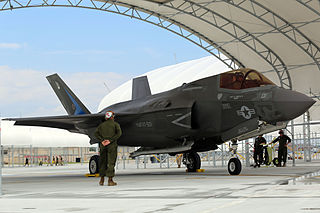
Marine Corps Air Station Beaufort or MCAS Beaufort is a United States Marine Corps air base located 5 kilometres (3.1 mi) northwest of the central business district of Beaufort, a city in Beaufort County, South Carolina, United States. About 4,700 personnel serve at the station, and it is home to four Marine Corps F/A-18 Hornet fighter-attack squadrons and two F-35B Lighting II training squadrons.

Naval Air Station Jacksonville is a large naval air station located approximately eight miles (13 km) south of the central business district of Jacksonville, Florida, United States.

Marine Fighter Attack Squadron 112 (VMFA-112) is a reserve United States Marine Corps McDonnell-Douglas F/A-18 Hornet squadron. The squadron is based at NASJRB Fort Worth, Texas and falls under the command of Marine Aircraft Group 41 (MAG-41), 4th Marine Aircraft Wing. Their tail code is MA. During World War II the squadron saw extensive action throughout the Pacific Theater of Operations especially at the Battle of Guadalcanal as part of the Cactus Air Force. By the end of the war, its 140 air-to-air kills ranked it third among Marine Corps squadrons.

Marine Fighter Attack Squadron 333 (VMFA-333) was a United States Marine Corps fighter squadron consisting of F/A-18 Hornets. Known as the "Fighting Shamrocks" and “Trip Trey”, the squadron participated in action during World War II, the Vietnam War and Operation Desert Storm The squadron’s aircraft were easily recognizable by the row of three shamrocks painted on the vertical stabilizers of their aircraft. They were decommissioned on 31 March 1992.

The 4th Marine Aircraft Wing is the reserve airwing of the United States Marine Corps. It is headquartered in New Orleans, Louisiana but its subordinate units are scattered throughout the United States.

Naval Air Station Oceana or NAS Oceana is a United States Navy Naval Air Station located in Virginia Beach, Virginia. The base is under the jurisdiction of Navy Region Mid-Atlantic and is the headquarters of Strike Fighter Wing Atlantic and Carrier Air Wings 1, 3, 7 and 8. As home to all east coast strike fighter jet squadrons, the Naval Air Station is classified as a master jet base. The airfield is known as Apollo Soucek Field, named after Lieutenant Apollo Soucek, a Navy Test Pilot who set the global altitude record in 1930 by flying a Curtiss "Hawk" biplane to an altitude of 43,166 feet.
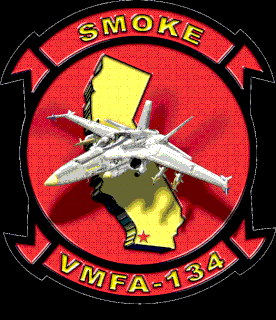
Marine Fighter Attack Squadron 134 (VMFA-134) was a reserve F/A-18 Hornet squadron in the United States Marine Corps. Known as "Smoke", the squadron was based at Marine Corps Air Station Miramar, California and fell under Marine Aircraft Group 46 (MAG-46) and the 4th Marine Aircraft Wing. On April 1, 2007, the squadron was transitioned to cadre status and its gear and personnel were redistributed throughout the remaining F/A-18 Hornet squadrons.

Strike Fighter Squadron 101 (VFA-101), also known as the "Grim Reapers", was a United States Navy Fleet Replacement Squadron (FRS) based at Eglin AFB, Florida. After the West Coast FRS for the F-14 Tomcat, VF-124, was disestablished in the mid-1990s, VF-101 became the sole F-14 FRS. At the time it was based at NAS Oceana in Virginia. With the retirement of the F-14, VF-101 was deactivated in 2005. It was reactivated in 2012 and redesignated Strike Fighter Squadron 101 (VFA-101). It was one of two F-35C Lightning II FRS before being deactivated in 2019. It was based at Eglin AFB, Florida with the joint 33d Fighter Wing, as a subordinate unit of the U.S. Navy's Strike Fighter Wing, U.S. Pacific Fleet.
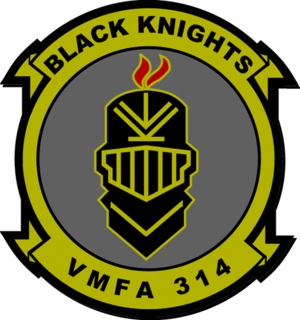
Marine Fighter Attack Squadron 314 (VMFA-314) is a United States Marine Corps F-35C Lightning II squadron. The squadron, known as the "Black Knights", is based at Marine Corps Air Station Miramar, California and falls under the command of Marine Aircraft Group 11 (MAG-11) and the 3rd Marine Aircraft Wing, but deploys with the US Navy's Carrier Air Wing Nine (NG).

Marine Aircraft Group 41 (MAG-41) is a United States Marine Corps reserve aviation unit based at Naval Air Station Joint Reserve Base Fort Worth, Texas that is currently composed of one F/A-18A++/C squadron, one KC-130J squadron, an aviation logistics squadron, as well as detachments from wing support and air control squadrons. Following decommissioning of Marine Aircraft Group 46 in 2009, MAG-41 also assumed command responsibility for the geographically separated Northrop F-5F aggressor squadron based at Marine Corps Air Station Yuma, Arizona and a Boeing Vertol CH-46 squadron HMM-764 based at Edwards Air Force Base, California. HMM-764 transitioned to the MV-22B in 2013 and relocated to MCAS Miramar.

Marine Aircraft Group 42 was a United States Marine Corps reserve aviation unit based at Naval Air Station Atlanta, Georgia. Due to a re-organization within Marine aviation, MAG-42 was deactivated on 21 June 2008.

Marine Fighter Attack Training Squadron 501 (VMFAT-501) is a training squadron in the United States Marine Corps, consisting of 28 F-35B Lightning II aircraft and serves as the Fleet Replacement Squadron. Known as the "Warlords," the squadron is based at Marine Corps Air Station Beaufort, South Carolina and falls administratively under Marine Aircraft Group 31 and the 2nd Marine Aircraft Wing. The squadron has assumed the lineage of VMFA-451 which was originally known as the “Blue Devils” and saw action during World War II and Operation Desert Storm. They were decommissioned on January 31, 1997.

Marine Fighter Attack Squadron 321 (VMFA-321) was a United States Marine Corps fighter squadron consisting of F/A-18 Hornets. Known as "Hell’s Angels", the squadron participated in action during World War II and was then transferred to the Marine Forces Reserve. The squadron was decommissioned on 11 September 2004.
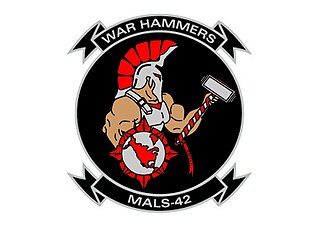
Marine Aviation Logistics Squadron 42 was a reserve aviation logistics support unit of the United States Marine Corps. They fell under the command of Marine Aircraft Group 42 and 4th Marine Aircraft Wing and were based at Naval Air Station Atlanta. MALS-42 provided direct support to VMFA-142 and HMLA-773 and Navy squadrons VAW-77 and VR-46 and indirect support to two tactical Marine squadrons HMLA-773 Det A and HMM-774. Due to a re-organization within Marine aviation, MALS-42 was deactivated in 2008.
The Tactical Support Wing (TSW) is a United States Navy reserve air wing whose primary mission is operational and training support for active forces. Based at Naval Air Station Joint Reserve Base Fort Worth, the wing is composed of five squadrons and five Squadron Augment Units (SAU) in seven states.

Marine Aviation Logistics Squadron 41 (MALS-41) is a reserve aviation logistics support unit of the United States Marine Corps. They fall under the command of Marine Aircraft Group 41 and 4th Marine Aircraft Wing and are currently based at Naval Air Station Joint Reserve Base Fort Worth. MALS-41 provides direct support to VMFA-112 and VMGR-234.

Naval Air Station Cecil Field or NAS Cecil Field was a United States Navy air base, located in Duval County, Florida. Prior to October 1999, NAS Cecil Field was the largest military base in terms of acreage in the Jacksonville, Florida area.
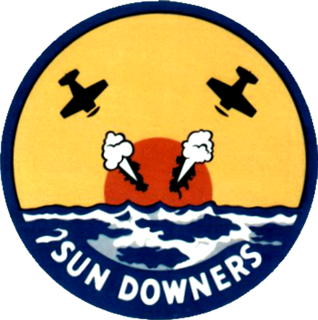
Fighter Squadron Composite 111 (VFC-111) Sun Downers is a US Navy Reserve adversary squadron based at Naval Air Station Key West, Florida (USA). Currently, it operates Northrop F-5N/F Tiger-IIs, of most of which are single-seater F-5Ns and one twin-seater F-5F, the "FrankenTiger". The Squadron is composed of experienced active duty junior officers, full-time support reservists, and selective reserves. This gives the squadron cutting edge real-world experiences, as well as leveraging off experience and retaining talented instructors that have left active service.























